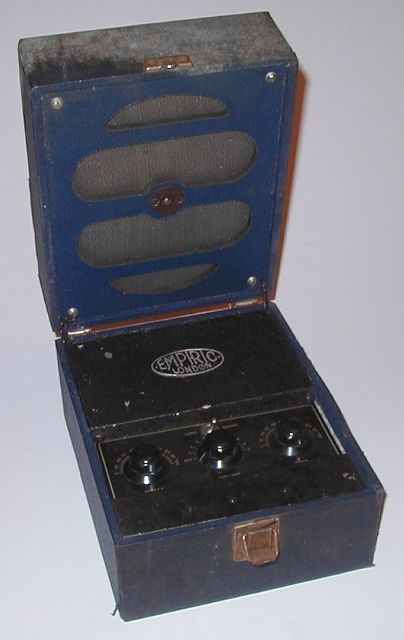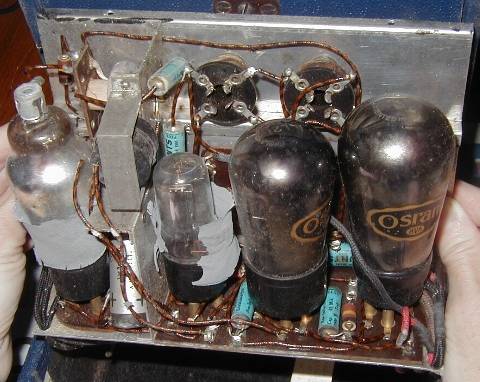 |
empiric portable trf vintage radio wireless detector museum vintage reaction fram aerial antenna
 |
This is a portable valve (tube) radio made by 'Empiric' of London c. 1935. Empiric is not a manufacturer that I am familiar with, but perhaps there is someone out there who does have further information.
The set is a very compact and light weight 4 valve (tube) set, measuring just 10" long x 8" wide x 6.5" deep (254mm x 203mm x 165mm). The set is housed in a leatherette covered plywood box with lift-up lid. The receiver and batteries are fitted into the base of the cabinet whilst the lid carries the reed type loudspeaker and MW & LW frame aerials.
The receiver is a 4 valve TRF design using what I suspect were novel construction techniques for the day. The following photograph shows an internal view of the receiver.
 |
Valve line-up is as follows (left to right in above picture):
S22* (tetrode RF amplifier); L21 (triode detector); HL2 (triode AF amplifier); P2 (triode AF output)
* the only residual type number marking on the RF valve is the last figure '2'. It is assumed, therefore, that it is in fact a type S22 made by the Marconi-Osram Co.
The majority of components in the detector/audio section are effectively 'surface mounted' onto a thin paxolin panel. Valves are fitted into skinny surface mounted sockets while many of the resistors and capacitors are soldered to tags riveted to the paxolin sheet. A further paxolin sheet insulates the circuit panel from the chassis metalwork.
No circuit diagram is available at present.
The circuit operates from a +67.5V HT battery, a 4.5V grid-bias battery and a 2V accumulator for the valve heaters.
|
|
Front panel controls comprise (lower left to right) 'SELECT', 'VOLUME' and 'TUNE'. There is also a switch behind the volume control to select LONG (wave) or SHORT (archaic term for the current MW band). The volume control incorporates a switch to disconnect the heater supply when the control is wound fully counter-clockwise.
I would very much like to hear from anyone who has further information on this set or its manufacturer.
Copyright Ó 2001 - 2002 Lorne Clark